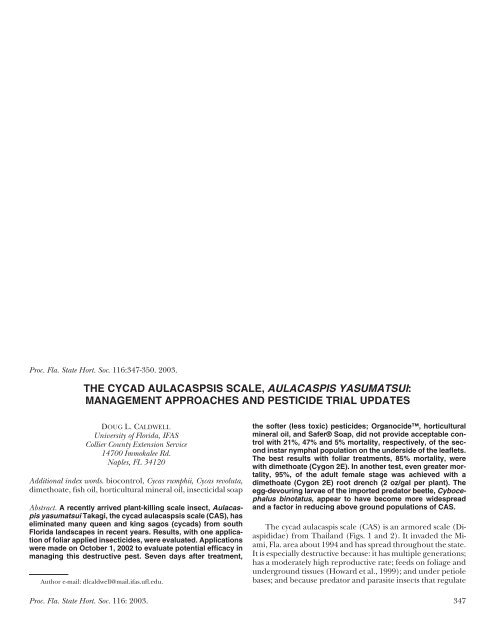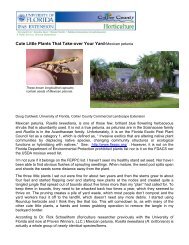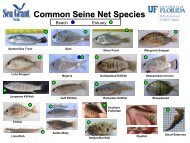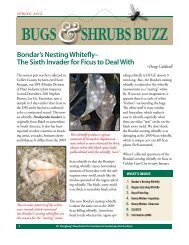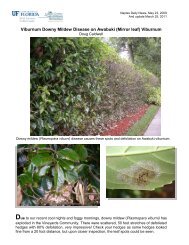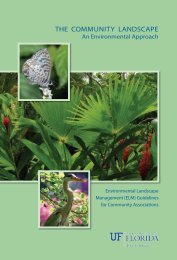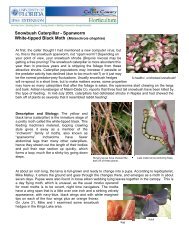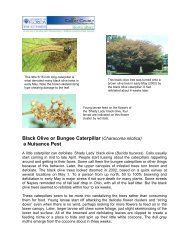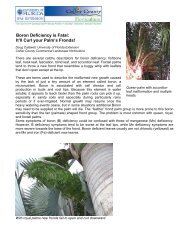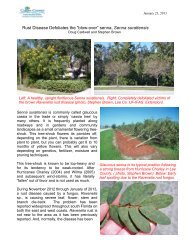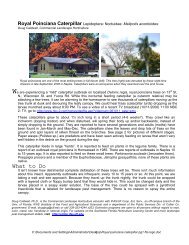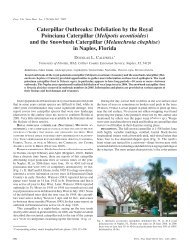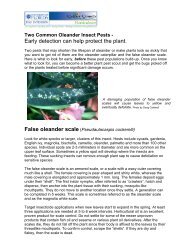the cycad aulacaspsis scale, aulacaspis yasumatsui: management
the cycad aulacaspsis scale, aulacaspis yasumatsui: management
the cycad aulacaspsis scale, aulacaspis yasumatsui: management
You also want an ePaper? Increase the reach of your titles
YUMPU automatically turns print PDFs into web optimized ePapers that Google loves.
Fig. 1. Hourly air temperatures taken 60 cm (~24 inches) above ground<br />
level in Tallahassee, Fla. January 23-24, 2003.<br />
Several freezes occurred in late fall 2002 but <strong>the</strong> lows<br />
reached were of a similar magnitude as those experienced in<br />
<strong>the</strong> preceding fall. In January 2003, Tallahassee experienced<br />
a hard freeze which lasted for several hours. On January 23,<br />
<strong>the</strong> air temperature dropped below freezing at approximately<br />
7:00 PM and continued to drop during <strong>the</strong> night and into <strong>the</strong><br />
morning of January 24 until a low of 16.7 °F was reached at approximately<br />
6:00 AM.<br />
The air temperature remained at this<br />
low point until shortly after 8:00 AM,<br />
when it began to rise.<br />
The temperature remained below freezing until after 11:00<br />
Proc. Fla. State Hort. Soc.<br />
116:347-350. 2003.<br />
AM (Fig. 1). The infested plants were inspected later in <strong>the</strong><br />
day of January 24. Severe freeze damage was noted on <strong>the</strong><br />
plant where <strong>the</strong> original infestation was noted. No aboveground<br />
live leaf tissue could be found. Therefore, leaf samples<br />
were collected from a Cycas revoluta adjacent to <strong>the</strong> original<br />
plant for assessment of <strong>scale</strong> viability. Live insects were<br />
found on <strong>the</strong> pinnae of <strong>the</strong> leaves.<br />
From <strong>the</strong>se observations, we can conclude that <strong>the</strong> Cycad<br />
Aulacaspis Scale are seemingly little affected by long-term<br />
(>4 h) exposure to temperatures below 20 °F. Cold temperatures<br />
which normally occur in <strong>the</strong> distribution range of Cycas<br />
revoluta are not low enough to significantly harm this insect,<br />
and <strong>the</strong> <strong>scale</strong>’s range is probably limited by its host’s tolerance<br />
to low temperatures ra<strong>the</strong>r than its own.<br />
Literature Cited<br />
DeHaven, W. R. 2002. Availability of an environmental assessment. Federal<br />
Register. 67:22037.<br />
Heu, R. A. and M. E. Chun. 1999 (revised 2000). Sago Palm Scale. State of<br />
Hawaii, Dept. of Agr. New Pest Advisory no. 99-01.<br />
Hodges, G. S., F. W. Howard, and E. A. Buss. 2003. Update on <strong>management</strong><br />
methods for Cycad Aulacaspis Scale. Fla. Coop. Ext. Ser. Bul. ENY-680.<br />
Howard, F. W., A. Hamon, M. McLaughlin, T. Weissling, and S-L Yang. 1999.<br />
Aulacaspis <strong>yasumatsui</strong> (Hemiptera: Sternorrhncha: Diaspididae), a <strong>scale</strong><br />
insect pest of <strong>cycad</strong>s recently introduced into Florida. Florida Entomologist<br />
82:14-27.<br />
Takagi, S. 1977. A new species of Aulacaspis associated with a <strong>cycad</strong> in Thailand<br />
(Homoptera: Cocoidea). Insecta Matsumaruana New Species 11:63-<br />
72.<br />
Weissling, T. J., F. W. Howard, and A. B. Hamon. 1999. Cycad Aulacaspis<br />
Scale, Aulacaspis <strong>yasumatsui</strong> Takagi (Insecta: Homoptera: Sternorrhyncha:<br />
Diaspididae). Fla. Coop. Ext. Ser. Bul. EENY-096.<br />
THE CYCAD AULACASPSIS SCALE, AULACASPIS YASUMATSUI:<br />
MANAGEMENT APPROACHES AND PESTICIDE TRIAL UPDATES<br />
DOUG<br />
L. CALDWELL<br />
University of Florida, IFAS<br />
Collier County Extension Service<br />
14700 Immokalee Rd.<br />
Naples, FL 34120<br />
Additional index words. biocontrol, Cycas rumphii, Cycas revoluta,<br />
dimethoate, fish oil, horticultural mineral oil, insecticidal soap<br />
Abstract. A recently arrived plant-killing <strong>scale</strong> insect, Aulacaspis<br />
<strong>yasumatsui</strong> Takagi, <strong>the</strong> <strong>cycad</strong> <strong>aulacaspsis</strong> <strong>scale</strong> (CAS), has<br />
eliminated many queen and king sagos (<strong>cycad</strong>s) from south<br />
Florida landscapes in recent years. Results, with one application<br />
of foliar applied insecticides, were evaluated. Applications<br />
were made on October 1, 2002 to evaluate potential efficacy in<br />
managing this destructive pest. Seven days after treatment,<br />
Author e-mail: dlcaldwell@mail.ifas.ufl.edu.<br />
<strong>the</strong> softer (less toxic) pesticides; Organocide, horticultural<br />
mineral oil, and Safer® Soap, did not provide acceptable control<br />
with 21%, 47% and 5% mortality, respectively, of <strong>the</strong> second<br />
instar nymphal population on <strong>the</strong> underside of <strong>the</strong> leaflets.<br />
The best results with foliar treatments, 85% mortality, were<br />
with dimethoate (Cygon 2E). In ano<strong>the</strong>r test, even greater mortality,<br />
95%, of <strong>the</strong> adult female stage was achieved with a<br />
dimethoate (Cygon 2E) root drench (2 oz/gal per plant). The<br />
egg-devouring larvae of <strong>the</strong> imported predator beetle, Cybocephalus<br />
binotatus, appear to have become more widespread<br />
and a factor in reducing above ground populations of CAS.<br />
The <strong>cycad</strong> <strong>aulacaspis</strong> <strong>scale</strong> (CAS) is an armored <strong>scale</strong> (Diaspididae)<br />
from Thailand (Figs. 1 and 2). It invaded <strong>the</strong> Miami,<br />
Fla. area about 1994 and has spread throughout <strong>the</strong> state.<br />
It is especially destructive because: it has multiple generations;<br />
has a moderately high reproductive rate; feeds on foliage and<br />
underground tissues (Howard et al., 1999); and under petiole<br />
bases; and because predator and parasite insects that regulate<br />
Proc. Fla. State Hort. Soc. 116: 2003. 347
<strong>the</strong> <strong>scale</strong> in its native range are slowly establishing in Florida.<br />
This <strong>scale</strong> insect has eliminated many queen and king sagos<br />
(<strong>cycad</strong>s) from south Florida landscapes.<br />
Queen sago, Cycas rumphii Miquel and king sago, Cycas revoluta<br />
Thunberg are used as focal plants in Florida landscapes.<br />
These plants were previously low maintenance, uniquely tropical,<br />
and used extensively, typically in entrance areas and o<strong>the</strong>r<br />
prominent locations. In <strong>the</strong> last few years, because of CAS,<br />
<strong>the</strong> use of <strong>the</strong>se plants is being questioned and <strong>the</strong> demand<br />
has been reduced. Some nursery managers are faced with<br />
large inventories that are not selling. Management attempts<br />
for CAS infestations have focused on repeated foliar applications<br />
of insecticides, monthly or more often. Infested <strong>cycad</strong>s<br />
suffer die-back of <strong>the</strong> lower fronds, which are typically<br />
pruned, thus creating a different plant form (bare trunk)<br />
that, to many people, is unappealing. Many infested plants<br />
have died within a 2 to 3 year time span due to rapid CAS resurgence<br />
from <strong>the</strong> hidden populations on <strong>the</strong> trunk or roots<br />
or untreated nearby plants. Thus, what was once a low-maintenance<br />
focal plant has become a high maintenance eyesore<br />
in <strong>the</strong> landscape. Plants are invariably removed in frustration<br />
with <strong>the</strong> CAS onslaught. Pesticide strategies are needed to<br />
slow <strong>the</strong> spread of this pest and protect infested plants until<br />
effective predators and parasites become more widely dispersed.<br />
Some foliar pesticide approaches are proposed by<br />
348<br />
Fig. 1. Cycad <strong>aulacaspis</strong> <strong>scale</strong>s have encrusted <strong>the</strong> petioles and fronds of this king sago. The CAS feeding activity has distorted <strong>the</strong> newly emerging fronds.<br />
Hodges et al. (2003). More data are needed on <strong>the</strong> efficacy of<br />
a single application approach with soft pesticides. From credibility,<br />
financial and logistical perspectives, landscape managers<br />
and maintenance companies prefer products that are<br />
effective with a single application, as opposed to frequently<br />
repeated applications.<br />
Finally, a root-absorbed systemic insecticide is needed to<br />
attempt <strong>management</strong> of <strong>the</strong> populations on <strong>the</strong> underground<br />
plant parts and under <strong>the</strong> petiole stubs on <strong>the</strong> trunk.<br />
A commonly used soft, root-absorbed, systemic insecticide,<br />
imidacloprid (Merit®, Bayer Corp.) has been reported as ineffective<br />
(Hodges et al., 2003).<br />
Materials and Methods<br />
Foliar Applications. An 8 ft, severely infested, queen sago in<br />
a Naples landscape was used for this foliar spray test. On 1<br />
Oct. 2002, three fronds were sprayed as a treatment block using<br />
25 oz. hand-misters (spritzer bottles). The pesticides, Organocide,<br />
Ortho horticultural mineral oil, dimethoate<br />
(Cygon®<br />
2E, Sou<strong>the</strong>rn Agriculture Insecticides, Inc.) and<br />
Safer® Soap were applied at label rates (Table 1). Both sides<br />
of <strong>the</strong> fronds were sprayed until thoroughly wet. Three untreated<br />
fronds served as a buffer between treated blocks. Using<br />
a microscope, five leaflets (a leaflet was used as replicate)<br />
Proc. Fla. State Hort. Soc. 116: 2003.
Fig. 2. The female test (wax covering) of <strong>the</strong> <strong>cycad</strong> <strong>aulacaspis</strong> <strong>scale</strong> is circular and <strong>the</strong> male has an elongate, narrow test. Some crawlers and a few second<br />
instar nymphs are present on <strong>the</strong>se distorted king sago leaflets.<br />
were examined from each treatment block; 20 individuals of<br />
each stage ( n = 100), adult females and second instar female<br />
nymphs, were examined. Mortality of <strong>the</strong> populations on <strong>the</strong><br />
upper leaf surface and lower (bottom) surface of <strong>the</strong> leaflets<br />
was calculated. Treatment results were evaluated at 7 d after<br />
treatment (DAT) on 8 Oct. 2002. No rainfall occurred during<br />
<strong>the</strong> test. Statistical analyses were conducted using ANOVA<br />
and Duncan’s New MRT, P = 0.05.<br />
Root Drench. On 3 Nov. 2002, three king sagos (8 to 12 inch<br />
trunk diameter and 12 to 28 inches tall, as measured from <strong>the</strong><br />
ground to <strong>the</strong> bud) in a Naples landscape were treated with a<br />
Cygon 2E drench. Each plant was treated with a solution of 1<br />
gal of water mixed with 2 oz of Cygon 2E. The solution was applied,<br />
with a watering can, directly on <strong>the</strong> soil within a 3-inch<br />
band around <strong>the</strong> entire trunk circumference. Three king sagos<br />
served as untreated checks. Plants were in irrigated beds.<br />
All plants had been previously pruned because of CAS damage,<br />
so that only <strong>the</strong> last 2 year’s foliage remained, ra<strong>the</strong>r than<br />
a full “head”. Adult female mortality was evaluated at 31 DAT.<br />
Twenty female <strong>scale</strong>s/leaflet, on each of four leaflets ( n = 80),<br />
per plant were examined using a microscope. In both tests<br />
<strong>the</strong> wax cover (test) was removed with an insect pin so that <strong>the</strong><br />
insect’s condition could be evaluated. The data were statistically<br />
compared using a t-test with P = 0.05.<br />
Results and Discussion<br />
Foliar Applications. Treatment mortality of individuals on<br />
<strong>the</strong> upper leaf surface was greater than mortality of individuals<br />
on <strong>the</strong> lower leaf surface (Table 1). However, <strong>scale</strong> populations<br />
are initially greater on <strong>the</strong> lower leaf surface during<br />
<strong>the</strong> early phase of an infestation, until <strong>the</strong>y overflow onto <strong>the</strong><br />
upper leaf surface. Higher mortality on <strong>the</strong> upper leaf surface<br />
of queen <strong>cycad</strong> leaflets may occur because <strong>the</strong>re is a “gutter”<br />
along each side of <strong>the</strong> mid-vein that holds <strong>the</strong> spray liquids<br />
longer, ra<strong>the</strong>r than <strong>the</strong> quick run-off that would occur on <strong>the</strong><br />
lower surface. Mortality on <strong>the</strong> lower surface of leaflets is<br />
more critical as that is where <strong>the</strong> <strong>scale</strong>s initially settle and are<br />
more abundant. The second instar nymphal stage is considered<br />
more vulnerable than <strong>the</strong> adult to an insecticide spray<br />
application because it has a thinner wax cover. This is evident<br />
in <strong>the</strong>se results, as <strong>the</strong> second instar nymphs suffered greater<br />
mortality than <strong>the</strong> adults in all treatments (Table 1).<br />
In this test, <strong>the</strong> indication of a chemical’s potential to<br />
manage this pest will be based on results with <strong>the</strong> second instar,<br />
on <strong>the</strong> lower side of <strong>the</strong> leaflets. The softer pesticides; Organocide,<br />
horticultural mineral oil, and Safer Soap, at <strong>the</strong><br />
recommended label rates, did not do well on this pest with<br />
21%, 47% and 5% mortality, respectively (Table 1). Mortality<br />
Proc. Fla. State Hort. Soc. 116: 2003. 349
Table 1. Efficacy of foliar applied pesticides on CAS adult female and second instar nymphal stages on a queen <strong>cycad</strong>, 7 DAT (days after treatment) in<br />
Naples, Fla. Means (± standard deviations), within columns, followed by <strong>the</strong> same letter, are not significantly different (P = 0.05, Duncan’s New MRT).<br />
Mortality was assessed on <strong>the</strong> upper leaf surface and <strong>the</strong> lower surface (bottom) of <strong>the</strong> leaflets. Each mean was derived by taking five leaflets per treatment<br />
and 20 individuals per leaflet (n = 100).<br />
Product applied Oct. 1, 2002<br />
Organocidez<br />
with <strong>the</strong> horticultural mineral oil was significantly greater necke) [Hymenoptera: Aphelinidae]. Intermittent CAS<br />
than <strong>the</strong> fish oil product. Cygon 2E provided <strong>the</strong> best control, suppression due to <strong>the</strong>se beneficials has been reported<br />
85% mortality, and was significantly better than all o<strong>the</strong>r (Hodges et al., 2003). In Collier County, <strong>the</strong> beneficials have<br />
treatments as a foliar application.<br />
been slow in catching up. In October 2002, during <strong>the</strong> foliar<br />
Root Drench. Mortality of <strong>the</strong> difficult-to-control adult fe- treatment trial, of 2000 <strong>scale</strong>s examined, about 0.6% had been<br />
males at 31 DAT, with a Cygon 2E drench (2 oz/gal per parasitized. However, later during <strong>the</strong> second test in <strong>the</strong> same<br />
plant), was 95%; whereas natural mortality on <strong>the</strong> check neighborhood in December, activity of <strong>the</strong> larvae of <strong>the</strong> pred-<br />
plants averaged 16%. The treatment mortality was significantator beetle, Cybocephalus binotatus, was especially evident. The<br />
ly greater (t-test 0.05) than <strong>the</strong> natural mortality. Cygon 2E is beetle larvae are found underneath <strong>the</strong> <strong>scale</strong> coverings feed-<br />
not labeled for use on <strong>cycad</strong>s. The EPA published a voluntary ing on eggs. Their feeding behavior helps clean <strong>the</strong> encrusted<br />
cancellation notice of dimethoate products for residential use <strong>scale</strong> layers off of <strong>the</strong> plant surface. In spring of 2003, CAS has<br />
in <strong>the</strong> Federal Register (Vol. 67, No. 7) on January 10, 2002 not flared up as quickly as in previous years and this may be<br />
(U.S. Environ. Protect. Agency, 2002). However, Dimethoate due to <strong>the</strong> apparent increase in activity of <strong>the</strong> beetle larvae.<br />
400 (Clean Crop®) has a label that permits root drench in Plant Resistance. Nursery managers and landscape archi-<br />
residential landscapes on a wide array of species until <strong>the</strong>ir tects should consider alternative plants that would fill a geo-<br />
new label is released. This product is only available in 2.5 gal metric niche similar to queen and king sagos, although<br />
containers. To avoid phytotoxicity, do not apply <strong>the</strong> root nothing quite matches up. Some alternatives include: Phoenix<br />
drench rate of Cygon 2E as a foliar application to newly ex- roebelenii O’Brien;<br />
Crinum spp.; Agave spp.; Yucca spp.; but <strong>the</strong><br />
panding fronds, as necrosis of <strong>the</strong>se tender tissues occurred grandest and most appealing match is Dioon spinulosum Dyer<br />
on a king sago that was not in <strong>the</strong>se tests.<br />
These trials are an initial evaluation. Management of CAS<br />
or o<strong>the</strong>r similar Dioon spp.<br />
needs more extensive investigation. Long-term <strong>management</strong><br />
data, insecticide impact on <strong>the</strong> hidden populations; and for<br />
Literature Cited<br />
<strong>the</strong> homeowner, <strong>the</strong> effects of multiple applications of <strong>the</strong> Hodges, G. S., F. W. Howard, and E. A. Buss. 2003. Update on <strong>management</strong><br />
soft pesticides bear continued evaluation. New systemic insecticides<br />
that are moving into <strong>the</strong> horticultural arena are being<br />
evaluated for CAS <strong>management</strong> in several University of Florida<br />
locations.<br />
methods for <strong>cycad</strong> <strong>aulacaspsis</strong> <strong>scale</strong>. ENY-680. Entomology and Nematology<br />
Dept., Fla. Coop. Ext. Serv., Inst. Food Agr. Sci., Univ. Fla. 4 pp.<br />
Howard, F. W., A. Hamon, M. McLaughlin, T. Weissling, and S-L. Yang. 1999.<br />
Aulacaspis <strong>yasumatsui</strong> (Hemiptera: Sternorrhynca: Diaspididae), a <strong>scale</strong><br />
insect pest of <strong>cycad</strong>s recently introduced into Florida. Fla. Entomol.<br />
Biological Control. Two natural enemies that attack this <strong>scale</strong><br />
in Thailand were introduced into south Florida beginning in<br />
1997-98 (Howard and Weissling, 1999). They are a predaceous<br />
beetle, Cybocephalus binotatus Grouvelle [Coleoptera: Nitidul-<br />
82:14-27.<br />
Howard, F. W. and T. J. Weissling. 1999. Questions and answers about <strong>the</strong><br />
<strong>cycad</strong> <strong>aulacaspsis</strong> <strong>scale</strong> insect. Proc. Fla. State Hort. Soc. 112:243-245.<br />
U.S. Environ. Protect. Agency. 2002. Dimethoate; Receipt of Requests for<br />
Amendments and Cancellations. Federal Register Environmental Docuidae]<br />
and a parasitic wasp, Coccobius fulvus (Compere and Anments. Jan. 10. 67: 1345-1348.<br />
350<br />
Product (gal)<br />
per 100 gal water<br />
7 DAT % mortality ± S.D.<br />
adult females<br />
7 DAT % mortality ± S.D.<br />
2nd instar nymphs<br />
Upper Lower Upper Lower<br />
1.56 46 ± 19 b 8 ± 8 b 79 ± 33 ab 21 ± 11 cd<br />
Ortho Hort. Mineral Oil 2.0 84 ± 20 a 19 ± 21 ab 100 ± 0 a 47 ± 20 b<br />
Safer® Insecticidal Soap (concentrate) 2.0 12 ± 9 c 1 ± 2 b Not counted 5 ± 4 d<br />
Cygon 2E (dimethoate) y<br />
0.52 71 ± 29 ab 35 ± 24 a 88 ± 8 a 85 ± 14 a<br />
Check 1 ± 2.2 c 5 ± 4 b 54 ± 21 b 23 ± 16 c<br />
zSesame<br />
(5%) and fish oil (92%), from Organic Lab, Stuart, FL.<br />
yCygon<br />
2E label, 2002, excludes use on ornamentals in residential landscapes. The existing label does not list <strong>cycad</strong> plants. The 2003 Dimethoate 400 label<br />
allows root drench treatments.<br />
Proc. Fla. State Hort. Soc. 116: 2003.


